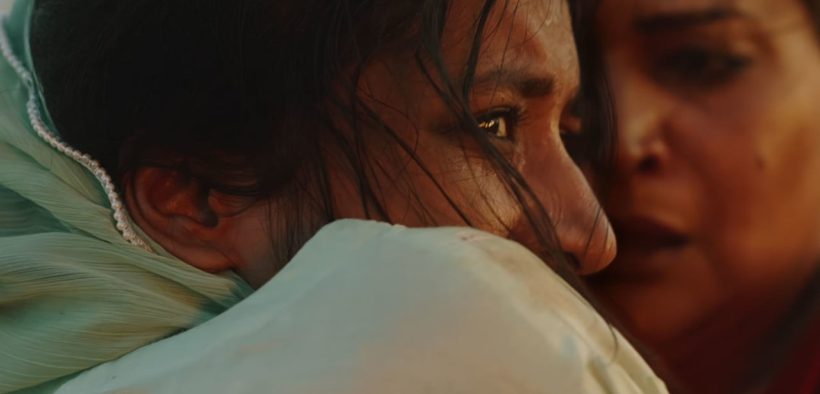Review: The compelling argument of patriarchy as terror in “In Flames”

The vultures tighten their flight in the sky overhead, always observing, as death lingers in the air of the city. The Pakistani-Canadian director Zarrar Kahn makes a remarkable debut with In Flames, a genre movie that expands on his 2018 short film Dia and explores the emotional horrors of patriarchy.
As the producer for the project, Anam Abbas works with Kahn to bring Pakistan back to the Cannes Directors’ Fortnight for the first time since Jamil Dehlavi’s 1980 submission, The Blood of Hussain, was chosen. With its outstanding sound design and striking graphics, it’s understandable why In Flames has generated festival hype and received a nomination for the Toronto International Film Festival.
The three-member family is placed in the wake of a death in the opening scene. As Mariam, a medical student caught between a new summer romance and the guarded cynicism Karachi demands to live, Ramesha Nawal is a welcome change of pace.
Bakhtawar Mazhar presents a harsh portrait of a middle-class widow named Fariha who is too preoccupied with taking care of her young son Bilal, who is in school, and her late father’s debts to be a good parent to her daughter. Here comes Adnan Shah Tipu’s Uncle Nasir, who graciously offers to pay all their obligations.
The main relationship in the movie is flanked by Natasha Noorani’s breakup song, Choro, which likewise foreshadows its tragic conclusion and rests on top like a haunting. In terms of style, the movie’s sound design stakes a stronger claim to the horror subgenre than its breathtaking photography.
After her grandfather’s funeral, Mariam gets in the car and drives out from her house to get some fresh air. Before an unfamiliar man comes in with a brick, the sound of the collision is strangely muffled and a light pop song plays on the car radio like a warning bell. The meeting shatters the unity of the senses—sound and sight, body and mind. The main relationship in the movie is flanked by Natasha Noorani’s breakup song, Choro, which likewise foreshadows its tragic conclusion and rests on top like a haunting. In terms of style, the movie’s sound design stakes a stronger claim to the horror subgenre than its breathtaking photography.
After her grandfather’s funeral, Mariam gets in the car and drives out from her house to get some fresh air. Before an unfamiliar man comes in with a brick, the sound of the collision is strangely muffled and a light pop song plays on the car radio like a warning bell. The meeting shatters the unity of the senses—sound and sight, body and mind. Similar to the man with the brick, Mariam’s love interest Asad shows up at the crime scene unexpectedly and with great persistence. He is first seen looking through her damaged car window at the camera. Before long, Asad is busting out the “good guy” routine, provoking fights with passersby, and pressuring Mariam to call the police.
Soon after they leave the police station, he asks for her number, and Mariam gives it to him as a way of saying “good guy.” However, something is still wrong. As the young couple becomes closer, strange things start to happen. A man sits in a chair in her darkened room while she speaks to him on the phone at night.
The collaboration between Kahn and Aigul Nurbulatova, his director of photography, works effectively on film. The film’s growing sense of dread is enhanced by tight, medium shots. Through open doors and from behind curtain tassels, the camera observes. Mariam’s balcony is one spot where she frequently stands behind bars and under observation to watch the street from the balustrade.
The entire movie was filmed on location in the busy Gulistan-e-Jauhar neighborhood, which gives the production a very grounded everyday setting for the typical Karachiite. As generational pain and patriarchy push the two towards each other, Mariam and Fariha fear both the seen and the unseen amid disputes over inheritance rights and ghosts of the dead.
Flames mines the mundane for its macabre; its monsters resemble possibilities. The movie keeps telling us that the rickshaw driver, the helpful uncle, and the devoted boyfriend are the good guys—until they aren’t. Right away, the camera replicates Saleem, the rickshaw driver, and his creepy stare, but Mariam makes it home without incident.
Is it merely an idea? Nothing in the way of “evidence” supports this feeling. As Mariam engages with yet another self-proclaimed savior more regularly, we are prompted to question our own beliefs. As is often the case with horror films centered on such issues, the movie does an amazing job at expressing a lot in implication without using its subject as a creative license for sensationalism. This is especially true for a picture that heavily touches on sexual assault.
Perhaps the narrative’s sole flaw is its cliched use of murder as a dramatic means of catharsis. However, In Flames is successful in expressing the constant fear of what might happen? It pierces all interactions and lingers long after they are over.

I am a dedicated student currently in my seventh semester, pursuing a degree in International Relations. Alongside my academic pursuits, I am actively engaged in the professional field as a content writer at the Rangeinn website.








